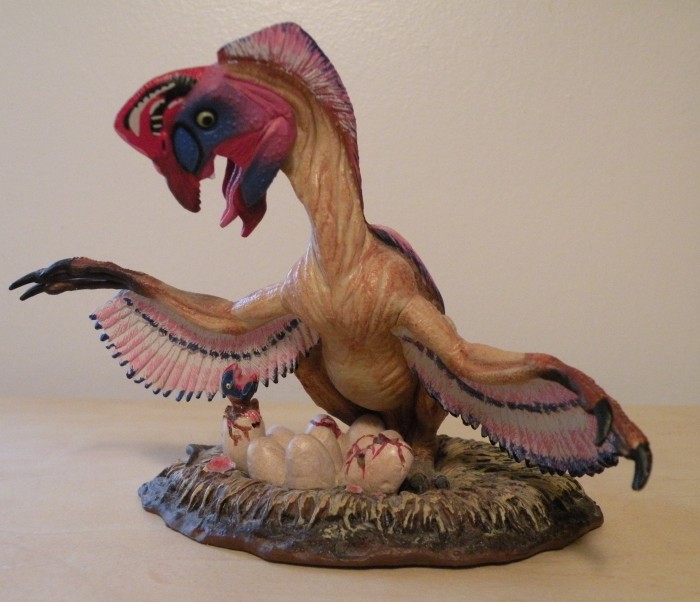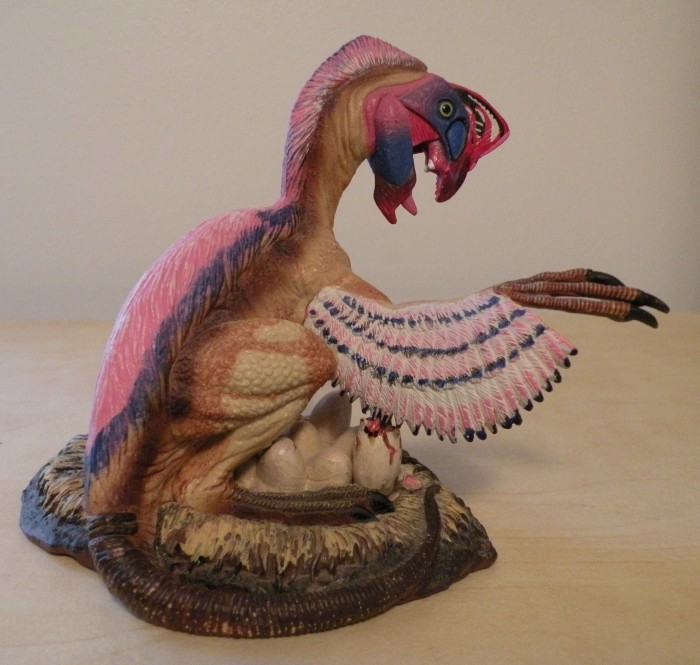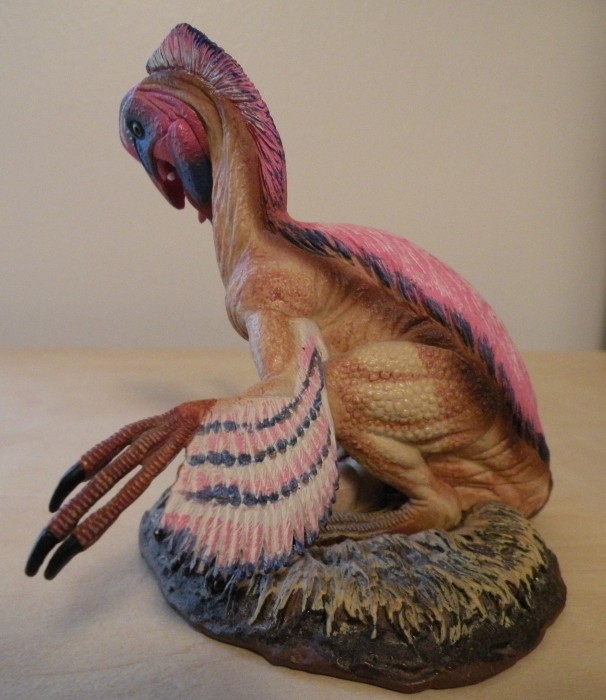Safari Ltd. recently announced their retirements for this upcoming year. On the list was the 2007 “Oviraptor on Nest” figure, part of their “Dino Discoveries” line. While discussing it on the forum I realized this spectacular little diorama has not been reviewed yet so here I am, reviewing it. The “Dino Discoveries” line consists of a series of fossil replicas as well as models depicting notable fossil finds, in this case the preserved fossils of Citipati brooding their nests. Though I say it is a spectacular model, it is far from flawless, but it has a lot of unique features that make up for its short comings. Indeed, it may very well be the model that “sparked” this dinosaur collecting hobby for me.
Sculpted in 1:10 scale this Oviraptor is in actuality the much more well known Citipati from Mongolia. It is usually Citipati that is depicted in the media as Oviraptor, the actual Oviraptor is only known from scant material. The model is heavily influenced by paleoartist Luis Rey and his depiction of brooding Citapati. The figure shows an adult Citipati looking down over its nest of eggs, all in various stages of hatching. I assume the adult is a male due to the bold coloration on the face but the chicks have the same coloration, maybe I’m just looking too much into it. Regardless of sex the parent looks to be a proud one and maybe a little bit surprised, looking down at its young with wings outstretched around them. The emerged chick looks ready for its first meal, fresh out of the egg.
The accuracy is hit and miss with this one. Certainly of note are the feathers, sculpted at a time when feathers were rare on model dinosaurs. The feathers are scant though, only present on the arms and running down the back. The arm feathers should extend down the middle finger but as is so often the case with these models they stop at the wrist. The rest of the body is naked, literally. The only scales are on the hands and feet, the rest is just naked skin like on an ostrich leg. The upper thigh does have some raised bumps that almost make it look like a plucked chicken. I like this over having the animal half scaly. It shows that this animal probably descended from a fully feathered ancestor. Still, a full body covering would have been preferable. One has to wonder how it incubated its eggs against its fleshy body instead of a nice warm downy covering but all well, it is still far more realistic than the brooding Maiasaura put out by Carnegie in their early years.
Perhaps the most glaring problem with the model is the tail. It is certainly the biggest issue I have with it. The tail is wrapped around the nest, no doubt to save space but while the body is flesh colored the tail is a much darker shade of brown and it starts very near the attachment point for the tail, which makes it look like it was literally tacked on. The tail also has a bizarre series of rings going all the way down the length. This in conjunction with the dark brown make it look much more like a rat tail or an earth worm than the tail of a bird-like theropod dinosaur. To the model’s credit, the rest of the anatomy looks pretty spot on, in particular the head which is very nicely sculpted and detailed right down to the bizarre tooth-like projections on the roof of the mouth. Oh yeah, the hands are not pronated. It’s almost an obligation to state whether or not they are in these reviews.
Aesthetically you’ll either love or hate this model, much like Luis Rey’s paleoart. As is the norm for him this model is presented in a very wide array of psychedelic colors that most paleoartists wouldn’t dare paint their dinosaurs in. The body is a fleshy skin color (except for the rat tail) while the feathers are various shades of pink and purple. White gives way to light pink towards the base of the feathers which give way to full on purple near the tips, this applies to the feathers running down the back as well. Overall not a bad look but once again it is the head that really stands apart on this model. Meticulously painted, the head is purple and blue with a red beak. The crest is red as well but with a very sharp looking black and white design painted on it. The eyes are green with a black pupil, the hands and claws are painted black. As said before, the hatching chicks are painted similarly to the adult, though they lack the crest. The nest is your standard grassy sort of nest and sitting on a brown base. The paint application is very clean overall.
This bold, interesting and detailed model is an instant eye-catcher in any collection and although it suffers from its share of problems you’ll be hard pressed to find mass produced mini-dioramas of this caliber within its price range. It really is a well crafted piece of art and I truly wish Safari would produce more models like it. It not only represents one of the most exciting discoveries of its day but also the work of a highly acclaimed paleoartist. You can’t help but hold your gaze on it, it’s so animated and alive and beautiful to look at. The fact that it will be retired soon means you should probably get it while you can but I’m sure it should remain easy to find for some years to come.
Available from Amazon.com here.
Disclaimer: links to Ebay and Amazon on the DinoToyBlog are affiliate links, so we make a small commission if you use them. Thanks for supporting us!









[…] a nest of eggs that was assumed to belong to Protoceratops. But the discovery of several nesting Citipati specimens in the 1990s’ shows that Oviraptor was in fact only guilty of being a dutiful […]
Your review made me chase this diorama down. It arrived today and I’m very glad you convinced me! Thanks too for the Luis Rey comment – his blog turned out to be interesting on this model.
Glad to hear it, it always makes me happy to see my reviews help a fellow collector. It’s why I do this. Enjoy your new model!
This review made me decide to buy this figure asap. Since you stated it’s retirement. I really adore the figure, even though it has it’s inaccuracies. It now has a place among my other feathered beasts. Be they terrorbirds or feathered others. (Alexxitator)
On the tail, oviraptorosaur tails should be short anyway, because pygostyle, so it’s inaccurate beyond the ratty look.
I’ve always thought this was a gorgeous dinosaur (it has pride of place in my collection), but I never noticed the tail before; it’S hidden at the back and is the same colour as the stand so it never leapt out at me. I’m almost sorry you called it to my Attention now, ist a lot more noticabe and is a downside to my favorite figure
I felt the same exact same way when I first noticed it. Sorry I had to spoil it for ya.
Hombre, no es quizás una figura para muchos sobresaliente, pero para mí es una de mis figuras preferidas y yo le he puesto cinco estrellas con todo el cariño del mundo porque esta figuras no es fácil de esculpir y para mi modestísima opinión, compite incluso con figuras de resina.
Man, is not perhaps an outstanding figure to many, but for me is one of my favorite figures and I have laid five star hotel with all the love in the world because this figures is not easy to carve and my modest opinion, even competes with resin figures.
Your excellent review and photography just convinced me to add this to my collection.